
Download the PDF of this article
Tactile development is our sense of touch and plays a major part in our physical and emotional health. We all know the value of a soothing touch, the stimulation of a vigorous rub and the pain of a bruise or cut to the skin, but our tactile development is fundamental to a complex range of functions of both our body and our brain and is essential for learning and well-being.
Touch connects us to our world and to each other. We are always touching something even if it’s just our feet on the ground or the clothes we wear – even without our clothes on, our skin is being touched by the air around us!
‘Touch has been one of the predominating senses throughout evolution, is a predominant sensation at birth and probably continues to be more critical to human function throughout life than is generally recognised’ (Ayres 2005). Just think how important touch is to a newborn baby, who is not only comforted by being held or stroked but is also stimulated to feed and latch on to the breast or bottle by gentle touch to the face.
Our sense of touch actually began in the womb and we now know the value of skin-on-skin touch for newborn babies, especially those born prematurely. We are also beginning to understand that a lack of touch in the earliest days and months (and through life) can have a seriously detrimental effect on health, well-being and brain development.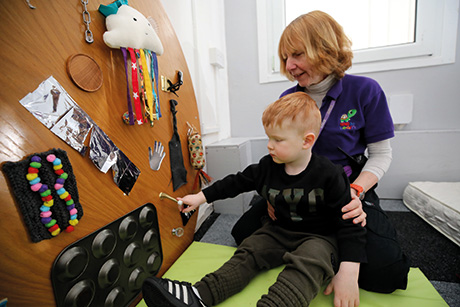
WHERE IS IT?
The tactile system is our largest sensory system as it covers the entire body from top to toe. We receive tactile information through receptors in our outer skin and also through the lining of the mouth, throat, digestive system, reproductive organs, ear canals, etc. Various touch sensations are picked up by these receptors and transported to the brain for processing along different ‘tracts’ (nerve cell bundles), depending on their function.
WHAT DOES IT DO?
Tactile sensations work in two ways, either protective or discriminative.
Protective: This works to not only alert us to potential harm but also to healthy ‘feelgood‘ touch that is beneficial.
The light touch of an insect crawling on your arm can instinctively cause you to brush it off, the burn from something hot teaches us to stay away. However, the touch of a baby’s soft skin or a pet’s fur encourages us to want to touch and be close to them.
Carol Stock Kranowitz describes these as either ‘uh oh’ or ‘okay’ sensations. One alerts us to threat or danger, the other lets us know this is a safe sensation.
Modulation (the ability to turn up or turn down our sensitivity to these protective sensations) develops as we increasingly interact with people and our environment. We need to learn to inhibit or ignore sensations that do not matter much, so that, as we get older, we can tolerate touches that would have irritated or alarmed us when we were infants.
Discriminative: This helps us discriminate and identify the kinds of touch we are experiencing. Kranowitz describes these as ‘aha’ sensations. The warmth of a parent’s skin, the stickiness of jam, the slipperiness of soap, the coldness of wet sand.
Experiencing these sensations over and over again helps us make connections and builds the insight and knowledge we need to interpret the world in which we live.
The receptors in our hands and feet, the mouth and tongue are especially active in responding to ‘touch pressure’, which is an essential part of tactile discrimination.
Kranowitz describes how these ‘aha’ moments give us very important information:
- That we are touching something – or that something is touching us
- Where on the body this touch occurs
- Whether the touch is light or deep
- How to perceive the attributes of an object such as its size, shape, weight, density, temperature and texture (Kranowitz 2005).
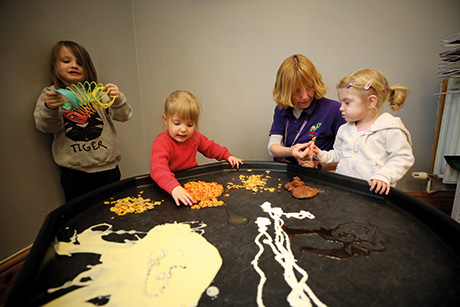
HOW DOES IT DEVELOP TYPICALLY?
By the time we are eight years old, our touch system is almost as fully developed as it will ever be (Ayres 2005), but a lot of important stuff has to take place first to develop that maturity. It is also involved in the perception of our other sensory systems (particularly proprioception).
We develop our tactile sense through lots of developmentally appropriate, ‘juicy’ tactile experiences throughout childhood, the kind that happen ‘again and again’ if they are pleasurable – and hopefully not too often if they are less so (e.g. bumps and grazes, changes of temperature, stings and prickles, etc). They are all part of the process of building a well-functioning tactile system that is alert to stimulus but is also able to adapt and modulate tactile sensation so that it doesn’t dominate the brain.
Daily life with people, animals, food, nature and the built environment is key to this but ideally supplemented by lots and lots of play with a variety of toys and materials. And don’t forget that getting dirty and messy plays a crucial part in children’s tactile development.
Healthy development
Smoothly operating tactile systems allow us to feel comfortable, enabling us to confidently interact with others and with our environment.
We know when to pay attention to tactile information and when to inhibit it in order to allow the brain to concentrate on more important things.
Tactile discrimination allows us to be able to find and categorise things by touch alone, e.g. finding something in the bottom of a bag full of stuff without looking.
Our tactile sense is closely linked with our emotional centres of the brain, allowing us to remember details and enabling us to make decisions based on whether the experience was pleasurable or not.
It assists with the development of proprioception, which help us build ‘internal body maps’ that promote a feeling of being ‘at home’ in our bodies.
Experiencing loving touch is crucial for attachment and for developing regulation and emotional health, enabling us to feel connected and ultimately able to relate to the feelings of others and to show empathy.
PROBLEMS WITH TACTILE PROCESSING
As with the other senses, sometimes there are problems modulating sensory input and issues with touch and tactile processing can take the form of under (hypo) sensitivity or over (hyper) sensitivity to stimulation.
Under-sensitive
This is the child who is constantly seeking more tactile stimulation and can never seem to get enough of it.
They might:
- need to constantly touch and feel everything they see, even if they shouldn’t (hot flame, fragile glass, etc.)
- crave deep pressure, hugs and squeezes and give them inappropriately
- impulsively get too close to others, bumping into and touching them even if asked not to
- take every opportunity to get dirty or messy and have no sense of ‘enough’ during these activities
- not register discomfort or pain from uncomfortable surfaces /textures or from injury
- take inappropriate risks and not learn from physical consequences.
Over-sensitive
This child resists touch and tactile stimulation and even a little of it can often be too much. This is sometimes referred to as ‘tactile defensiveness’ as the child will also respond negatively to the anticipation of being touched as well as unexpected touch sensations.
They might:
- resist hugs and cuddles, especially from people they don’t know well
- struggle and resist when being dressed or physically helped
- be irritated by labels, seams etc. in clothes
- hate baths, showers, hair brushing/cutting, nail clipping
- be anxious about and avoid different surfaces and textures, e.g. walking barefoot on sand, grass, etc.
- seek comfort in familiar tactile comforters, e.g. blanket, soft toy
- avoid and resist getting messy or dirty.
It is possible to fluctuate between both kinds of behaviour. Some children may seem to have a high tolerance for pain and discomfort yet overreact to light touch sensations. This may sometimes be due to underlying hypervigilance caused by experience of physical and/or emotional neglect.
If the tactile discrimination system is immature or inefficient, this can affect our ability to make physical judgements and carry out tasks. This is important in many daily life skills as well as learning in school, where manual dexterity will be important for manipulating tools, materials and equipment.
SUPPORTING TACTILE DEVELOPMENT AT SEND TO LEARN NURSERY
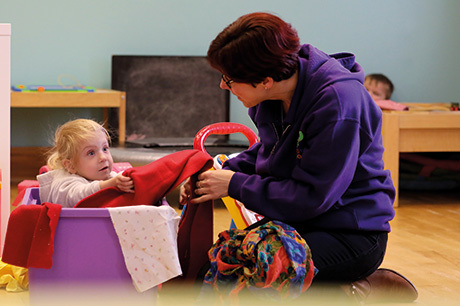
The sense of touch can generate powerful memories, and there is some crossover between sensory systems. There may be times when you cannot separate them as they are interdependent on each other, e.g. touch and proprioception, touch and oral sensitivity.
At SEND to Learn, we have children who are at both ends of the spectrum – for example, children who crave touch and are always covered in mess/wrapped up in something, and children who move away from the touch of others and will not go near any messy activity.
Under-sensitive
Both boys and girls can crave tactile sensory play, and life for these children can be very messy, full of bath times and changes of clothes.
At SEND to Learn we had a boy and girl (both with very different medical conditions) who loved nothing better than climbing right into the messy play activities and getting themselves and anyone else who was near them covered in whatever was in the tray. Our approach to this was to strip them down to their nappies or underwear and have plenty of spare clothes at hand.
These children needed to be in the middle of all this wet, gooey mess to help them understand their bodies and their sense of touch. They got so much delight out of these activities, whether with food such as jelly, baked beans and custard, or non-edible but safe items such as shaving foam, gloop, baby lotion, paint, playdough and chalk.
We taught the children to try to keep the messy items in the designated area and to accept some limited time restrictions as there was a tendency for them to become over-stimulated. Dry items or different textured materials would be added to the more ‘wet’ items to expand the children’s experiences. Messy play can always be taken outdoors to add to the fun. Invest in a mud kitchen or muddy/ soil area and it is often easier to clean up.
For those children who crave the touch of another person/object/fabric, etc. a different approach is taken (please bear in mind that some children crave both).
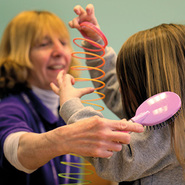 We had a little boy who constantly requested squeezes, liked being wrapped up in blankets. The approach we took for this was to provide boxes filled with different types of fabric and we used therapy balls for squeeze time (a trained member of staff would gently roll the therapy ball over the child to provide them with the sensory input they required). We provided sensory trays with different textures, and built dens with lots of cushions, beanbags and fabric. The child would often take part in storytime, sitting on a practitioner’s knee or leaning into them. We also work with the children on understanding ‘safe touch’ and ‘appropriate touch’.
We had a little boy who constantly requested squeezes, liked being wrapped up in blankets. The approach we took for this was to provide boxes filled with different types of fabric and we used therapy balls for squeeze time (a trained member of staff would gently roll the therapy ball over the child to provide them with the sensory input they required). We provided sensory trays with different textures, and built dens with lots of cushions, beanbags and fabric. The child would often take part in storytime, sitting on a practitioner’s knee or leaning into them. We also work with the children on understanding ‘safe touch’ and ‘appropriate touch’.
Over-sensitive
We have a little boy who craves some touch but is also tactile defensive. He craves adult touch and will often try to climb up your body so he can wrap himself around you, but he will only touch metal objects and is really defensive about touching other things. This also reflects in his feeding and what he will touch and eat during meal times. He also dislikes putting his feet down on different surfaces.
We have developed a feeding programme for him in consultation with speech and language staff and a dietician to overcome his tactile oral sensitivity. This is proving very successful and he is now eating/mouthing a range of food items. He has cuddle time, tickling games and rough-and-tumble play to accommodate his need for touch. Safe metal objects such as a teaspoon have been used to replace his mouthing of other, less safe metal objects.
We also have a little girl who is over-sensitive and tactile defensive and finds it very difficult to touch messy, wet items including paint, does not like mess on her hands or face and does not like putting her feet down on the floor.
For both of these children we carry out focused sessions where they first put just their finger, then hand, into substances such as custard, playdough, TheraPutty, jelly, shaving foam, flour, cereal, etc. We put favourite toys (or photos of them) in the sand, water and messy trays to encourage children to reach in with their hands to take them out, cleaning them up if necessary. Tactile stepping stones encourage the children to walk on them and we make sensory trays that can be stepped in. We incorporate sensory activities into storytime, with books such as We’re Going on a Bear Hunt.
The boy is now walking (both with support and independently) on the grass outside and the little girl is crawling and touching the grass. She spent five minutes playing in the sandpit this week. Both of them also took part in our Bear Huntsensory story, putting their hand into each tray (which included grass, water, mud, twigs and fake snow). They are now starting to explore playdough.
These activities have enabled both children to access more of their learning environment, and new experiences have opened up for them.
WHERE TO BUY PRODUCTS
Suppliers that offer a range of tactile resources include:
SpaceKraft https://bit.ly/2WCzuOS
SensoryPlus https://bit.ly/2UsyMpY
Early Years Resources https://bit.ly/2JZeKiL
Learning Resources https://amzn.to/2Iaxb1B
Sensory Education https://bit.ly/2YMXW1S
Rhino Sensory UK https://bit.ly/2OIMTCd
Explore Your Senses https://bit.ly/2YL9AKQ
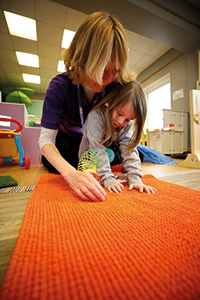 REFERENCES AND FURTHER READING
REFERENCES AND FURTHER READING
The Out of Sync Child by Carol Stock Kranowitz
Raising a Sensory Smart Child by Biel and Peske
Right from the Start by C Archer, L Manners, A O’Connor and J Pasch (Early Years Alliance)
Sensory Integration and the Child by A Jean Ayres
A Moving Child is a Learning Child by Gill Connell and Cheryl McCarthy
Understanding Physical Development: Linking bodies and brains by Anne O’Connor and Anna Daly
NB: Clinical assessments of sensory processing issues must be carried out by an appropriately qualified occupational therapist. Always seek advice and guidance if you are concerned about a child.
ABOUT THIS SERIES
Our five external senses (touch, sight, hearing, smell and taste) and three internal senses (interoceptive, vestibular and proprioceptive) are constantly sending messages to our brains – a process that we often barely register. Yet this sensory information is vital in helping us understand and make sense of the world.
Typical sensory development occurs naturally in childhood. However, for some children this doesn’t happen, causing sensory processing difficulties that impair development and are manifested in children’s behaviour.
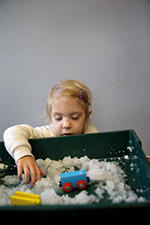 Advice and support
Advice and support
Part one of this series provides an introduction to typical and atypical sensory processing and integration. The rest of the series looks at the senses individually, explaining the causes, symptoms and effects of sensory problems and giving advice on how to adapt provision and practice to address a child’s sensory difficulties.
Series authors
Anne O’Connor is an early years consultant and author, specialising in the Prime areas of development (www.primedforlife.co.uk).
Dr Kath Dickinson is owner of SEND to Learn Nursery in Blyth, Northumberland. She has a doctorate in SEND (autism).









